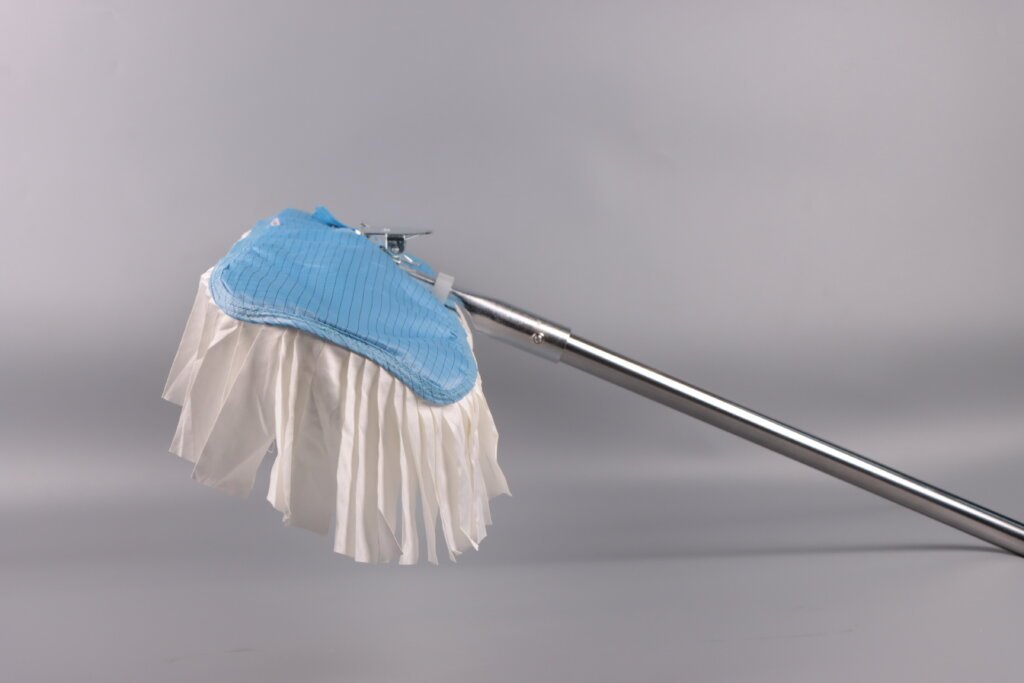Introduction
In contamination-controlled environments, every cleaning tool matters. One of the most essential tools is the Cleanroom Mop. Choosing the right mop is critical for maintaining compliance, reducing particle contamination, and improving cleaning efficiency.
This guide helps industries understand how to choose the right cleanroom mop. We’ll cover mop types, materials, and which mop suits specific cleanroom environments.
What is a Cleanroom Mop?
A cleanroom mop is a specialized cleaning tool designed for sterile and particle-sensitive environments. Unlike traditional mops, it is made from low-linting materials, often sterilizable, and compatible with disinfectants and cleaning agents used in cleanrooms.
Key features include:
-
Non-shedding mop heads
-
Chemical compatibility
-
ESD-safe options
-
Sterile packaging for cleanroom use
Keywords: Cleanroom Mops, low-lint mop, cleaning tool for cleanroom

Why Choosing the Right Mop Matters
Cleanrooms vary by ISO classification, industry needs, and surface type. Using the wrong mop can lead to:
-
Particle contamination
-
ESD issues
-
Chemical incompatibility
-
Reduced cleaning effectiveness

Types of Cleanroom Mops
1. Flat Head Mops
Flat mops are lightweight and easy to use. They are excellent for smooth floors and walls.
Best for:
-
ISO Class 3–5 cleanrooms
-
Semiconductor & electronics industries
Advantages:
-
Precise cleaning control
-
Compatible with pre-saturated wipes
-
Low linting
Keywords: Flat cleanroom mops, cleanroom floor mop

2. String Mops
String mops are more absorbent and better for larger areas or uneven surfaces.
Best for:
-
ISO Class 6–8 environments
-
Pharmaceutical & biotech sectors
Advantages:
-
High absorbency
-
Reusable heads
-
Great for spill control
Keywords: string mop, cleanroom absorbent mop
3. Foam Mops
Foam mops provide gentle contact and are ideal for delicate equipment or hard-to-reach spaces.
Best for:
-
Precision optics and lens manufacturing
-
Medical device assembly
Advantages:
-
Minimal abrasion
-
Even chemical distribution
Keywords: cleanroom foam mop, non-abrasive mop

4. Sterile Mops
Sterile mops are gamma irradiated or autoclaved. They are sealed in sterile pouches for controlled environments.
Best for:
-
Pharmaceutical cleanrooms
-
Hospitals and labs
Advantages:
-
Ready to use
-
Pre-sterilized
-
Supports GMP and FDA compliance
Keywords: sterile cleanroom mops, pre-sterilized mop

Key Features to Consider
1. Material
-
Polyester: Low particle release, ideal for high ISO classes
-
Microfiber: High absorbency, traps particles well
-
Foam: Smooth surface cleaning
-
Mop Frames: Usually stainless steel or plastic (autoclavable)
2. Compatibility
Make sure the mop head is compatible with:
-
Disinfectants
-
Solvents
-
Autoclaves or gamma sterilization
3. Handle Design
-
Adjustable aluminum or stainless steel handles
-
Ergonomic grip
-
Color coding for zone control

Industry Applications: How to Choose the Right Cleanroom Mop
1. Semiconductor Industry
Requirements:
-
ISO 3–5
-
Electrostatic discharge control
-
High precision surface cleanliness
Recommended Mop: Flat head mop with ESD-safe properties and polyester covers
Keywords: semiconductor cleanroom mops, anti-static mop
2. Pharmaceutical Manufacturing
Requirements:
-
Sterile environment
-
ISO 5–7
-
GMP and FDA compliance
Recommended Mop: Sterile polyester mop with gamma irradiation
Features:
-
Cleanroom packaged
-
Ready to use
-
Compatible with disinfectants
Keywords: pharma cleanroom mops, sterile mop system
3. Biotech & Laboratories
Requirements:
-
Biological control
-
Spillage absorption
-
Safe cleaning near samples
Recommended Mop: String mop or foam mop with high absorbency
Keywords: lab cleanroom mops, biotech mop system
4. Medical Device Industry
Requirements:
-
Gentle cleaning for instruments
-
No fiber shedding
-
ISO 6 or better
Recommended Mop: Microfiber mop with foam backing
Keywords: cleanroom mops for medical, microfiber mop head
5. Aerospace and Optics
Requirements:
-
Scratch-free surfaces
-
ISO 4 or better
-
No particulate damage
Recommended Mop: Foam mop with low abrasion surface
Keywords: optics cleanroom mops, aerospace cleanroom cleaning tool

How to Maintain Cleanroom Mops
-
Clean and sterilize regularly
-
Store in cleanroom-compatible packaging
-
Replace mop heads per usage guidelines
-
Color-code mop sets by room or zone
Pro Tip: Do not use the same mop for cleanroom floor and walls. Cross-contamination must be avoided.

OEM & ODM Cleanroom Mops Services
Looking for custom cleanroom mop solutions?
We offer:
-
Custom mop head materials
-
Private-label packaging
-
Bulk supply for global cleanrooms
-
Color-coded sets for multi-zone use
Our team ensures your mop system aligns with ISO, GMP, and industry-specific standards.

Conclusion
Choosing the right cleanroom mop depends on your industry, cleanroom class, and application. From sterile environments to ESD-sensitive zones, there’s a mop designed for every critical area.
By selecting the right mop type — flat, string, foam, or sterile — and matching it with proper materials, you ensure efficient cleaning, particle control, and regulatory compliance.
Need expert advice or OEM solutions for your cleanroom mop requirements?
Contact us today for tailored support and high-performance products.



-4-1.jpg)

-4.jpg)